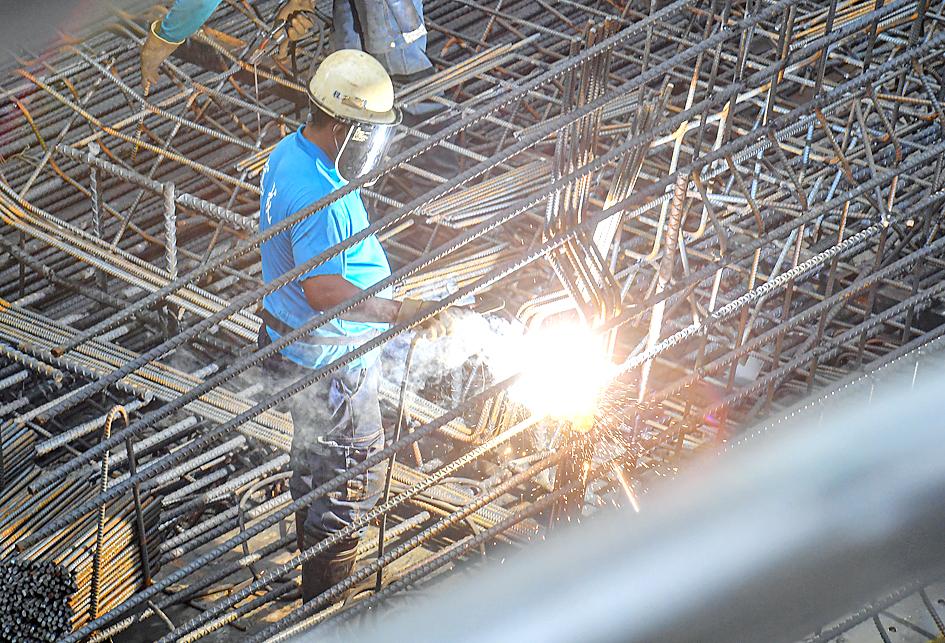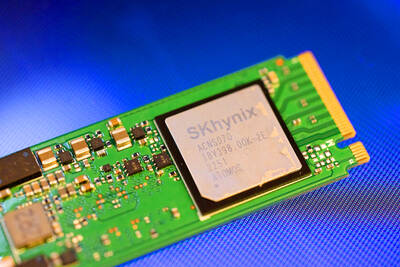Industrial production last month rose 16.51 percent year-on-year, a 16th consecutive month of annual growth at a pace that was faster than April’s 14.1 percent rise, as demand in the electrical and traditional sectors remained bullish, the Ministry of Economic Affairs reported yesterday.
The output of the manufacturing sector, which makes up more than 90 percent of total industrial production, rose 17.28 percent last month from a year earlier, also marking a 16th straight month of year-on-year growth, the ministry said.
On a monthly basis, industrial production rose 4.31 percent, while manufacturing output increased 3.51 percent, it said.

Photo: CNA
Department of Statistics Deputy Director-General Huang Wei-jie (黃偉傑) attributed the performance to increased demand for 5G, high-performance-computing and automotive chips, while demand for information and communications technology (ICT) products stayed strong due to the increase in distance learning and remote working during the COVID-19 pandemic.
The output of electronic components last month increased 14.71 percent year-on-year, the 18th month of double-digit percentage growth, ministry data showed.
“This is a big engine for growth in manufacturing,” Huang said.
Semiconductor suppliers saw production rise 12.59 percent from a year earlier, while production posted by flat-panel makers soared 21.75 percent thanks to the booming stay-at-home economy, he said.
The strong stay-at-home economy also increased demand for computers and optoelectronic items, with production rising 10.14 percent from a year earlier, the data showed.
Traditional manufacturing — which was hit hard by economic slowdowns following the spread of the virus — “came roaring back,” Huang said.
“We are seeing year-on-year growth of more than 20 percent in most categories thanks to a global economic recovery,” he said, adding that last year’s lower comparison base also contributed to the increase last month.
The output of chemical material makers last month rose 22.03 percent year-on-year, while base metal makers saw output rise 24.22 percent and machinery makers 32.42 percent, the data showed.
The output of auto and auto parts makers increased 49.81 percent year-on-year thanks to strong demand for passenger vehicles at home and for auto parts abroad, the data showed.
In the first five months of this year, industrial production rose 13.76 percent from the same period last year, with the output of the manufacturing sector increasing 14.63 percent, the ministry said.
Industrial production this month should continue to rise, barring fallout from a rise in COVID-19 infections, Huang said.
The department predicts annual growth of 10.6 percent to 14 percent for this month, and an increase of 14.2 percent to 15.4 percent for the second quarter as a whole.
“Although the pandemic situation in Asia appears to be intensifying, as Europe and the US open up and increase their infrastructure programs, we can look forward to greater momentum in manufacturing moving forward,” Huang added.

Taiwan Semiconductor Manufacturing Co (TSMC, 台積電) secured a record 70.2 percent share of the global foundry business in the second quarter, up from 67.6 percent the previous quarter, and continued widening its lead over second-placed Samsung Electronics Co, TrendForce Corp (集邦科技) said on Monday. TSMC posted US$30.24 billion in sales in the April-to-June period, up 18.5 percent from the previous quarter, driven by major smartphone customers entering their ramp-up cycle and robust demand for artificial intelligence chips, laptops and PCs, which boosted wafer shipments and average selling prices, TrendForce said in a report. Samsung’s sales also grew in the second quarter, up

On Tuesday, US President Donald Trump weighed in on a pressing national issue: The rebranding of a restaurant chain. Last week, Cracker Barrel, a Tennessee company whose nationwide locations lean heavily on a cozy, old-timey aesthetic — “rocking chairs on the porch, a warm fire in the hearth, peg games on the table” — announced it was updating its logo. Uncle Herschel, the man who once appeared next to the letters with a barrel, was gone. It sparked ire on the right, with Donald Trump Jr leading a charge against the rebranding: “WTF is wrong with Cracker Barrel?!” Later, Trump Sr weighed

HEADWINDS: Upfront investment is unavoidable in the merger, but cost savings would materialize over time, TS Financial Holding Co president Welch Lin said TS Financial Holding Co (台新新光金控) said it would take about two years before the benefits of its merger with Shin Kong Financial Holding Co (新光金控) become evident, as the group prioritizes the consolidation of its major subsidiaries. “The group’s priority is to complete the consolidation of different subsidiaries,” Welch Lin (林維俊), president of the nation’s fourth-largest financial conglomerate by assets, told reporters during its first earnings briefing since the merger took effect on July 24. The asset management units are scheduled to merge in November, followed by life insurance in January next year and securities operations in April, Lin said. Banking integration,

LOOPHOLES: The move is to end a break that was aiding foreign producers without any similar benefit for US manufacturers, the US Department of Commerce said US President Donald Trump’s administration would make it harder for Samsung Electronics Co and SK Hynix Inc to ship critical equipment to their chipmaking operations in China, dealing a potential blow to the companies’ production in the world’s largest semiconductor market. The US Department of Commerce in a notice published on Friday said that it was revoking waivers for Samsung and SK Hynix to use US technologies in their Chinese operations. The companies had been operating in China under regulations that allow them to import chipmaking equipment without applying for a new license each time. The move would revise what is known